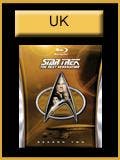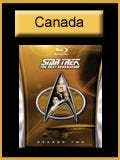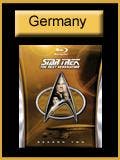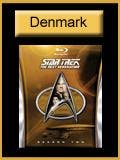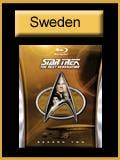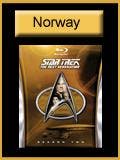Published Dec 3, 2012
Looking Back At TNG With Director Rob Bowman, Part 1
Looking Back At TNG With Director Rob Bowman, Part 1

Rob Bowman was just 27 years old when he directed “Where No One Has Gone Before,” the first of 13 Star Trek: The Next Generation episodes he would go on to shoot. Several of them are fan favorites. It’s 25 years later and Bowman is still at the top of his game, producing and directing episodes of the hit series Castle. In between TNG and Castle, he produced and/or directed such shows as Quantum Leap, Parker Lewis Can’t Lose, The A-Team, The X-Files and Day Break, and directed the films The X-Files, Reign of Fire and Elektra. It’s been a while since Bowman directed a feature, but he’s been represented on the big screen recently by… The Next Generation. When two episodes played theatrically this past summer to celebrate the Season One Blu-ray set, they were the Bowman-helmed “Where No One Has Gone Before” and “Datalore.” Just last week, fans enjoyed a theatrical showing of two second-season hours from the Season Two Blu-ray set – which will be available tomorrow – and one of them, “Q Who?,” was directed by Bowman. StarTrek.com recently tracked Bowman down in an editing suite as he put the final touches on an upcoming Castle episode, and he recounted hooking up with TNG, shared memories of shooting his episodes and filled us in on his Castle work. Below is part one of our extensive conversation, and check back again tomorrow for part two.Let’s start with Star Trek: The Next Generation. How do the words “25 years” ring to you?Bowman: It’s mind-blowing. The fact that it’s also got the staying power, it’s amazing. We worked hard back then and tried to make them good and tried to make them look good. Who knew that they’d stick like this?A lot of shows are good and lovingly made. Why do you think TNG endures?Bowman: I think it has something to do with the use of metaphors and themes that are universal. They’re not talking about some (then-) current galactic spatial problem. They’re talking about people’s lives in similes and metaphors and whatnot that are reflective of any time. I’m not saying that Star Trek is the only show that ever did that, but it just seems that people are willing to watch a reflection of their own life, but because it’s not in present day or in a neighborhood, because it’s in outer space, it doesn’t seem like they’re being spoken to or lectured to. It just seems these characters are trying to figure out how to get by, and people can relate to it. That’s the only thing I can think of.You were so young when you were brought in to direct your first episode. What did Bob Justman say to you as to why you were chosen?Bowman: When I showed up for the interview and was taken into his office, he paused (laughs), and he said, “You’re very young.” Well, what am I going to say? I go, “Well, I am what I am.” He had a moment to himself and said, “Well, I really liked your reel. So, OK, fine.” Then there’s the old story of Rick Berman popping his head in the door and saying, “Pizza.” I said, “Excuse me?” He said, “We ordered pizza. Are you the delivery boy?” I think he was playing with me, but I said, “No, I’m Rob Bowman, and I’m hoping I’m your next director.” But that became my nickname for quite a while. He’d probably still say it to me today if he saw me.
The first episode you did was “Where No One Has Gone Before.” Were you daunted? Did you like the script? What was your mindset heading into it, assuming you can remember that far back?Bowman: Oh, I remember it very well. The script didn’t bother me. But the sets were huge. If I’ve got this right, the sets were refashioned from one of the movies, and so they had a lot of scope and scale, but we’d only have five or six people on the bridge. How do I shoot the production value and then get all the coverage I need? I didn’t want to sacrifice anything. There’s no reason to be on a multi-million-dollar set and then not photograph it. I actually spent a month prior to filming hanging out on the sets and figuring out angles I liked. Then, once I got the script, I already had a point of view about what trajectories and geometry I was looking for within the sets that existed, and then we built the scenes and blocked the scenes within that. Of course, I was I nervous, but hopefully just because I wanted to make it good. But I was extremely prepared when I started shooting. I know that.At what point did Rick or Bob say to you, “Good job, kid. Be ready to stick around. We’re going to give you more work to do here”? And when did you start to feel comfortable? Bowman: I felt comfortable and I locked in during that first episode. And I think it was also during that episode when they said, “Would you come back for more?” I said, “Of course.” I had no idea I’d be back so many times.We’re not going to ask you to go through all 13 episodes of TNG that you did, but please do revisit some of them with us. “Datalore” is a fan favorite…Bowman: “Datalore” has an interesting back story. The first steps of that were that there was a script in the pipeline, which was made, which was “The Big Goodbye.” I was very excited to direct that. I think I was near the end of “Too Short a Season,” the one where Clayton Rohner gets younger during the story. Rick called me and said, “Look, ‘The Big Goodbye’ is not ready. We’re going to give you ‘Datalore.’” I’d heard, if I remember correctly, that "Datalore" took a while to get right. So I went to Brent and I said, "It sort of feels like we’re being given the script that nobody wants or whatever it is. Let’s prove everybody wrong or make everybody proud. Let’s work together and make this a classic.” Brent was like, “Yeah, let’s go.” His ability to delineate those brothers… I felt like I had the best seat in the house, saying “Action” and watching him do it. We were both really keen on making that a special show. We were like, “Fine, ‘The Big Goodbye’ is going to be a fun script, but we’re going to make this one even more popular if we can.” I remember that, and I remember feeling really good during the shoot, and also giggling at Brent’s dexterity. He was just unbelievable.Visit StarTrek.com again tomorrow to read part two of our exclusive interview with Rob Bowman.
____________________________
Season Two is a 5-disc set that includes all 22 episodes, as well as more than 120 minutes of brand-new documentaries that include recently recorded cast and crew interviews. Fans can expect an extended version of the episode “The Measure of a Man,” audio commentaries, a gag reel, Archival Mission Logs and Featurettes (among them “Reunification: 25 Years After The Next Generation” and “Making It So: Continuing The Next Generation”). Season Two will be available for the suggested retail price of $129.99 in the U.S.
You can pre-order Season Two on Blu-ray by clicking your country below.

